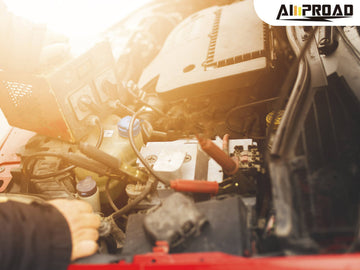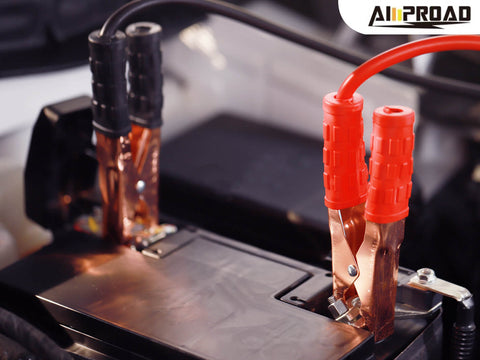
Imagine you're running errands and come back to find your car dead in its tracks. A drained battery can leave you stranded, but fear not! A jump start can get you back on the road. Traditionally, jumper cables have been the go-to solution for reviving a dead car battery. However, portable jump starters have emerged as a challenger, offering a convenient, one-person option. This article explores why jumper cables remain a relevant choice for jump-starting your car, even with portable jump starters in the mix. We'll delve into the advantages and limitations of both methods, helping you decide which is the right fit for your needs.
Why Jumper Cables Are Still Relevant?
In an age of advanced technology, jumper cables remain a fundamental tool for vehicle owners facing dead batteries. Here's why they continue to be relevant:
Cost-effective:
One of the primary advantages of jumper cables is their affordability. Compared to jump starters, which can be relatively expensive, jumper cables come at a much lower upfront cost. This makes them accessible to a wide range of vehicle owners, including those on a tight budget.
Simple to use:
Jumper cables are straightforward to use, making them an attractive option for both experienced drivers and novices alike. The process involves connecting the cables to the battery terminals of both vehicles, starting with the donor car and then the vehicle with the dead battery. Once connected, the donor car's engine is started, transferring power to the dead battery and allowing the vehicle to start.
No charging required:
Unlike jump starters, which need to be pre-charged before use, jumper cables are always ready to go. There's no need to worry about keeping them charged or carrying around an additional device. As long as you have a set of jumper cables in your vehicle, you're prepared for unexpected battery failures.
Can jump multiple vehicles on a single charge (of the donor car):
Another advantage of jumper cables is their ability to jump-start multiple vehicles on a single charge, provided the donor car has enough power. This can be particularly useful in situations where both the needing car and the donor car have partially depleted batteries. With jumper cables, you can quickly and efficiently get multiple vehicles back on the road without the need for additional charging.
What Are the Limitations of Jumper Cables?
While jumper cables are a valuable tool for jump-starting vehicles, they do have some limitations to consider: No worry about how to boost a car with them.
Requires a second vehicle:
One of the main limitations of jumper cables is that they rely on the availability of another vehicle with a functional battery. If you're stranded in a remote location or in an area with limited traffic, finding a willing donor vehicle can be challenging. Additionally, if the donor vehicle is unable to access your vehicle due to parking constraints or physical barriers, jumper cables may not be an option.
Safety concerns:
Proper usage of jumper cables is crucial to avoid electrical hazards and potential damage to the vehicles involved. Connecting the cables incorrectly or allowing the clamps to touch can result in sparks, electrical shock, or damage to the electrical systems of both vehicles. It's essential to follow safety guidelines carefully, including ensuring both vehicles are turned off, connecting the cables in the correct order, and keeping the clamps away from moving parts.
May not be readily available:
While jumper cables are a common automotive accessory, not everyone may have them readily available in their vehicle. Some drivers may overlook the importance of carrying jumper cables or assume they won't encounter battery issues. As a result, when faced with a dead battery, they may find themselves without the necessary equipment to jump-start their vehicle. This highlights the importance of proactive vehicle maintenance and preparedness, including keeping essential tools like jumper cables in your vehicle's emergency kit.
Portable Jump Starters: A Viable Alternative?
Advantages:
No second car needed:
One of the primary advantages of portable jump starters is their independence from a second vehicle. Unlike jumper cables, which require the assistance of another car with a functioning battery, portable jump starters contain their own power source, allowing them to jump-start a vehicle on their own.
Compact and portable:
Portable jump starters are designed to be lightweight and compact, making them easy to store in a vehicle's trunk or glove compartment. Their smaller size and portability make them a convenient alternative to bulky jumper cables, particularly for drivers with limited storage space.
Additional features:
Many portable jump starters come equipped with additional features, such as built-in LED flashlights, USB ports for charging electronic devices, and even air compressors for inflating tires. These extra functionalities enhance the versatility and usefulness of portable jump starters, making them a valuable tool to have in emergency situations.
Limitations:
Higher cost:
While portable jump starters offer convenience and independence, they typically come with a higher price tag compared to traditional jumper cables. The added cost may deter some drivers from investing in a portable jump starter, especially if they rarely encounter battery-related issues.
Requires charging:
One drawback of portable jump starters is that they require charging before use. If the jump starter is not adequately charged or maintained, it may not be able to provide enough power to jump-start a vehicle when needed. This reliance on charging adds an extra step to the process and may lead to situations where the jump starter is not ready when an emergency arises.
May not have enough power for all vehicles:
While portable jump starters are suitable for most standard vehicles, they may not have enough power to jump-start larger vehicles or those with completely dead batteries. Drivers of trucks, SUVs, or diesel vehicles should carefully consider the power output of the portable jump starter to ensure it meets their needs.
Choosing Between Jumper Cables and Portable Jump Starters
When deciding between jumper cables and portable jump starters, several factors come into play:
Driving habits:
Consider your typical driving habits and the likelihood of encountering battery-related issues. If you frequently travel long distances or find yourself in remote areas with limited access to assistance, a portable jump starter may provide added peace of mind.
Typical driving distance:
Drivers who mainly commute short distances may find jumper cables to be sufficient for their needs. However, if you frequently embark on longer journeys or travel through areas with limited service stations, a portable jump starter with its independent power source may be a more reliable option.
Budget:
Evaluate your budget and determine how much you're willing to invest in a jump-starting solution. Jumper cables are typically more affordable upfront compared to portable jump starters, making them a budget-friendly option for many drivers.
Access to reliable help on the road:
Consider your access to reliable assistance on the road. If you frequently travel with others or have access to roadside assistance services, jumper cables may suffice. However, if you prefer to be self-sufficient or often travel alone, a portable jump starter can provide added security and independence.
Additionally, for drivers seeking a portable jump starter solution with advanced features and reliability, the AMPROAD portable jump starter is worth considering. With its compact design and powerful lithium-ion battery, the AMPROAD jump starter provides the versatility and convenience needed to jump-start vehicles in emergency situations. Equipped with features such as built-in LED lights, USB charging ports, and multiple safety protections, including reverse polarity protection and over-current protection, the AMPROAD jump starter offers peace of mind and added functionality on the road. Whether you're facing a dead battery or need to charge your electronic devices, the AMPROAD portable jump starter is a reliable companion for drivers looking for a comprehensive jump-starting solution.
Ultimately, the decision between jumper cables and portable jump starters depends on your individual needs and preferences. Drivers who prioritize cost-effectiveness and simplicity may opt for jumper cables, while those seeking added convenience and peace of mind may prefer the versatility of a portable jump starter. Assessing your driving habits, typical driving distance, budget, and access to reliable help on the road will help you make an informed decision that best suits your needs.
FAQs / People Also Ask
Q1: What are jumper cables?
Jumper cables are a pair of insulated wires with alligator clips on each end, used to connect the battery of one vehicle to another to jump-start a dead battery.
Q2: Are jumper cables still useful in modern vehicles?
Yes, jumper cables remain relevant and useful in modern vehicles, as battery failures can still occur due to various reasons such as leaving lights on, extreme temperatures, or aging batteries.
Q3: How do jumper cables work?
Jumper cables transfer electrical current from a functioning battery (in the donor vehicle) to the dead battery (in the recipient vehicle), providing the necessary power to start the engine.
Q4: Are jumper cables easy to use?
Yes, jumper cables are relatively easy to use, especially for those familiar with the process. Simply connect the cables to the battery terminals of both vehicles, start the donor vehicle, and then the recipient vehicle.
Q5: What are the advantages of using jumper cables?
Jumper cables are cost-effective, simple to use, and require no charging. They also allow for jumping multiple vehicles on a single charge (of the donor car), making them a practical solution in emergency situations.
Q6: Are there any safety concerns with using jumper cables?
Proper usage of jumper cables is crucial to avoid electrical hazards and potential damage to the vehicles involved. It's important to follow safety guidelines carefully, including ensuring both vehicles are turned off and connecting the cables in the correct order.




